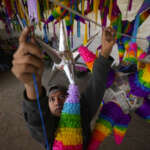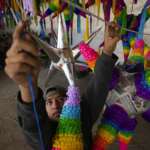A Closer Look at Mexico
Mexico Flag

Mexico Formation Date
September 16, 1810
Mexico Capital Name
Mexico City
Mexico Neighbours
Exploring Mexico
Introduction
Mexico, officially known as the United Mexican States, is a country located in the southern portion of North America. It shares borders with the United States to the north, Guatemala and Belize to the south, and the Pacific Ocean to the west and the Gulf of Mexico and Caribbean Sea to the east. With a population of over 129 million people, Mexico is the 11th most populous country in the world. The name "Mexico" is derived from the Aztec word "Mexica," which refers to the indigenous people who inhabited the region before the Spanish conquest.Key Takeaways
- Mexico is a country located in North America, bordered by the United States, Guatemala, and Belize.
- The name "Mexico" comes from the Aztec word "Mexica."
- Mexico has a population of over 129 million people.
Geography
Mexico's geography is diverse and includes a variety of physical features such as mountains, deserts, and coastlines. The Sierra Madre Occidental and Sierra Madre Oriental mountain ranges run through Mexico, while the Sonoran and Chihuahuan deserts cover large portions of the northern region. The country also has a long coastline along the Pacific Ocean, Gulf of Mexico, and Caribbean Sea. Mexico is rich in natural resources, including oil, natural gas, silver, copper, and gold. These resources contribute significantly to Mexico's economy and play a crucial role in its trade relations with other countries. The climate in Mexico varies depending on location. The northern regions experience hot summers and mild winters, while the central and southern regions have a more tropical climate with rainy summers. The coastal areas are generally hot and humid year-round.Origin and History
Mexico has a rich history that dates back thousands of years. The region was home to several ancient civilizations, including the Olmecs, Mayans, and Aztecs. These civilizations left behind impressive architectural ruins and artifacts that are still studied and admired today. In 1519, Spanish conquistador Hernán Cortés arrived in Mexico and conquered the Aztec Empire. This marked the beginning of Spanish colonization in Mexico, which lasted for over 300 years. In 1821, Mexico gained its independence from Spain and became a republic. Since gaining independence, Mexico has experienced political turmoil, economic growth, and cultural development. Today, it is a vibrant and diverse country with a unique blend of indigenous and Spanish influences.Government and Politics
Mexico is a federal presidential representative democratic republic with a multi-party system. The President of Mexico serves as both the head of state and government and is elected for a six-year term. The country is divided into 31 states and one federal district, with each state having its own governor and legislature. The federal government has control over issues such as foreign relations, national security, and trade. Mexico has a complex relationship with its northern neighbor, the United States, with issues such as immigration and trade often causing tension between the two countries.Commerce and Economy
Mexico has one of the largest economies in Latin America, with a gross domestic product (GDP) of over $1 trillion. The country's economy is primarily driven by the service sector, which accounts for about 60% of the GDP. Other significant sectors include manufacturing, agriculture, and tourism. Mexico has strong trade relationships with countries such as the United States, Canada, China, and Japan. Its main exports include manufactured goods, oil, silver, fruits, and vegetables. The official currency of Mexico is the Mexican peso (MXN), which is divided into 100 centavos.Demographics
Mexico has a diverse population, with the majority being of Mestizo (mixed indigenous and European) descent. Indigenous peoples make up about 21% of the population, with the largest groups being the Nahua, Maya, and Zapotec. The country also has a significant population of expats from the United States, Canada, and Europe. The most populous cities in Mexico are Mexico City, Guadalajara, and Monterrey. The average age in Mexico is 29 years old, with a life expectancy of 77 years.Culture
Mexico's culture is a vibrant mix of indigenous and Spanish influences. The country is known for its colorful art, music, festivals, traditions, and cuisine. Some of the most famous Mexican traditions include Dia de los Muertos (Day of the Dead), which is celebrated on November 1st and 2nd, and Cinco de Mayo, which commemorates the Mexican army's victory over the French in 1862. Mexican art is characterized by bright colors and intricate designs. Famous Mexican artists include Frida Kahlo, Diego Rivera, and Rufino Tamayo. Music is an essential part of Mexican culture, with traditional genres such as mariachi and ranchera being popular throughout the country. Mexican cuisine is also well-known worldwide for its delicious flavors and use of fresh ingredients like corn, beans, and chilies.Languages and Religion
Spanish is the official language of Mexico and is spoken by the majority of the population. However, there are also over 60 indigenous languages spoken throughout the country, including Nahuatl, Maya, and Zapotec. Catholicism is the dominant religion in Mexico, with about 83% of the population identifying as Catholic. Other religions practiced in Mexico include Protestantism, Judaism, and Islam. Religion plays a significant role in Mexican society, with many religious holidays and traditions celebrated throughout the year.Education and Healthcare Systems
Education in Mexico is free and compulsory for children between the ages of 6 and 14. The country has a literacy rate of over 95%, with several prestigious universities, including the National Autonomous University of Mexico (UNAM) and the Monterrey Institute of Technology and Higher Education (ITESM). Mexico's healthcare system is a mix of public and private institutions. The public healthcare system is funded by the government and provides free or low-cost services to citizens. Private healthcare is also available for those who can afford it. In recent years, Mexico has made significant strides in improving its healthcare system, with a focus on expanding access to quality care for all citizens.Sports and Recreation
Football (soccer) is the most popular sport in Mexico, with the national team having a long history of success in international competitions. Other popular sports include baseball, boxing, and bullfighting. Mexico has also hosted several major sporting events, including the FIFA World Cup in 1970 and 1986 and the Pan American Games in 1955, 1975, and 2011. In addition to sports, Mexico offers a variety of recreational activities such as hiking, surfing, and exploring ancient ruins.Tourism
Mexico is a top tourist destination, attracting millions of visitors each year. The country's diverse landscape, rich culture, and warm hospitality make it an ideal vacation spot for travelers from all over the world. Some of the most popular tourist attractions in Mexico include the ancient city of Teotihuacan, the beaches of Cancun and Puerto Vallarta, and the colonial cities of Guanajuato and San Miguel de Allende. Mexico also has a well-developed tourism infrastructure, with a range of accommodations, transportation options, and activities for visitors to enjoy.Travel Information for Foreign Visitors
If you are planning to visit Mexico, here are some essential travel information and tips to keep in mind:Visa Requirements
Citizens of many countries, including the United States, Canada, and most European nations, do not need a visa to enter Mexico for tourism purposes. However, it is always best to check the latest requirements with the Mexican embassy or consulate in your country before traveling.Health and Safety
While Mexico is generally a safe country to visit, there are some areas that travelers should avoid due to high levels of crime. It is recommended to research your destination and take necessary precautions while traveling.Local Customs and Etiquette
Mexicans are known for their warm hospitality and friendly nature. When visiting someone's home, it is customary to bring a small gift for the host. Tipping is also expected in restaurants and for other services.Currency and Payment Methods
The official currency of Mexico is the Mexican peso (MXN). Most establishments accept credit cards, but it is always good to have some cash on hand for smaller purchases.Places to Visit
Some must-see places in Mexico include the ancient city of Chichen Itza, the beaches of Tulum, and the vibrant capital city of Mexico City.Prices
Mexico is generally an affordable destination for travelers. Prices vary depending on location and season, but budget-friendly options can be found throughout the country.Quotes
- "Mexico is a land of enchantment, a place where magic and reality blend together." - Unknown
- "In Mexico, we have a word for sushi: bait." - Jose Simon
- "Mexico is a mosaic of different realities and beauties." - Enrique Pena Nieto
Conclusion
Mexico is a country with a rich history, diverse culture, and stunning landscapes. From its ancient civilizations to its modern cities, Mexico offers something for everyone. With a booming economy and a focus on improving education and healthcare, the future looks bright for this vibrant nation. So, whether you are looking for a relaxing beach vacation or an adventure-filled trip, Mexico is the perfect destination to explore.Mexico Highest Point Name
The highest point in Mexico is Pico de Orizaba (also known as Citlaltépetl) which stands at an elevation of 18,491 feet (5,636 meters).
Mexico Capital Longitude
-99.133208
Mexico Capital Latitude
19.432608
Mexico Official Languages
The official language of Mexico is Spanish. Local indigenous languages are also widely spoken, including Nahuatl, Yucatec Maya, Otomi and Mixtec.
Mexico Ethnic Groups
Mexico is a culturally and ethnically diverse country. The largest ethnic group is the Mestizo, a person of mixed Spanish and indigenous Mexican descent. The second largest is the indigenous population, composed of several different groups, including the Nahua, Mixtec, Zapotec, Totonac, Maya, and Otomi. Other notable ethnic groups include whites of Spanish descent, as well as Afro-Mexicans, Asians, and Arab-Mexicans. Smaller immigrant communities from Europe and Central and South America have also contributed to Mexico's diversity.
Mexico Religions
In Mexico, the majority of citizens are Roman Catholic, accounting for over 80% of the population. Other Christian denominations are present, including Protestantism, Seventh-Day Adventists and Mormons. Judaism is practiced by a small minority. Other belief systems also exist among Mexico's people, such as indigenous religions, Islam, and Buddhism. Indigenous religions in Mexico have a long history, believed to have first appeared in the region about 1500 BC. Islam has been growing in popularity in recent years, estimated to represent 2-3% of the population. Buddhism is believed to be a much smaller percentage, with the main presence found in large cities.
Mexico Total Area
The total area of Mexico is 1,964,375 square kilometers (757,474 square miles).
Mexico Land Area
Mexico has a land area of 1,972,550 square kilometers (762,606 square miles).
Mexico Water Area
Mexico covers about 297,000 square miles of water area, mostly within the Gulf of Mexico and the Caribbean Sea. Its other major bodies of water include the Pacific Ocean, Sea of Cortez, Mar de Cortes, Gulf of California, Mar Caribe, and Rio Grande.
Mexico Total Population
As of July 2020, the estimated total population of Mexico is 126.2 million.
Mexico Currency Name
The official currency of Mexico is the Mexican Peso (MXN / MX$. The symbol used for the Peso is $.
Mexico Currency Code
The currency code for Mexico is MXN.
Mexico Currency Symbol
The country currency symbol for Mexico is the Mexican Peso (MXN or Mex$).
Mexico Time Zones
- Standard Time: UTC-06:00
- Daylight Saving Time: UTC-05:00
Mexico operates on Central Standard Time of UTC-6 and does not observe Daylight Saving Time. The country uses the same time nationwide across all 23 time zones, throughout the year. The exceptions are the extreme Eastern and Western tip of the country wherein the time is UTC-5 during the remainder of year.
Mexico Calling Code
+52
Mexico Internet TLD
www.aveholidays.mx
How to Say "Mexico" In Different Languages?
- Portuguese Brazil
- México (pt-BR)
- Chinese
- 墨西哥 (zh-CN)
- Arabic
- المكسيك (ar-EG)
- French
- Mexique (fr-FR)
- German
- Mexiko (de-DE)
- Greek
- Μεξικό (el-GR)
- Hindi
- मैक्सिको (hi-IN)
- Indonesian
- Meksiko (id-ID)
- Italian
- Messico (it-IT)
- Japanese
- メキシコ (ja-JP)
- Dutch
- Mexico (nl-NL)
- Urdu
- میکسیکو (ur-PK)
- Polish
- Meksyk (pl-PL)
- Portuguese
- México (pt-PT)
- Russian
- Мексика (ru-RU)
- Korean
- 멕시코 (ko-KR)
- Spanish
- México (es-ES)
- Thai
- เม็กซิโก (th-TH)
- Turkish
- Meksika (tr-TR)
- Vietnamese
- Mê-hi-cô (vi-VN)
Mexico Popular Holidays
- New Year's Day
- 1 January
- Epiphany
- 6 January
- Feast of the Virgin of Candelaria
- 2 February
- Constitution Day
- 5 February (5 February)
- Buddha's Birthday
- 8 February
- Valentine's Day
- 14 February
- Flag Day
- 24 February
- Carnival
- 25 February (28 February)
- Loyalty Day
- 2 March
- Shrove Monday
- 5 March
- International Women's Day
- 8 March (8 March)
- Independence of Guadalajara
- 15 March
- Feast of St. Patrick
- 17 March
- Feast of St. Joseph
- 19 March
- Anniversary of the Birth of Benito Juarez
- 21 March
- Passion Sunday
- 25 March
- Good Friday
- 30 March
- Palm Sunday
- 1 April
- Easter Day
- 1 April
- Mexican Navy Day
- 7 April
- Day of Fasting and Prayer
- 15 April
- Feast of St. Mark the Evangelist
- 25 April
- Día del Niño
- 30 April
- Children's Day
- 30 April
- Mexican Labor Day
- 1 May
- Labor Day
- 1 May
- Fiesta de las Cruces
- 3 May
- Cinco de Mayo
- 5 May
- Feast of the Battle of Puebla
- 5 May
- Mother's Day
- 10 May
- Mexican National Anthem Day
- 10 May
- Mother's Day
- 10 May
- Teacher's Day
- 15 May
- Feast of San Isidro Labrador
- 15 May
- Flag Day
- 15 May
- Father's Day
- 16 May
- Mexican Air Force Day
- 18 May
- Corpus Christi
- 30 May
- Ascension Day
- 9 June
- Feast of St. Anthony of Padua
- 13 June
- Army Day
- 22 June
- Feast of St. John the Baptist
- 24 June
- Feast of the Virgin of San Juan de los Lagos
- 24 June
- Feast of the Virgin of San Juan
- 24 June
- Feast of St. Paul
- 29 June
- Feast of St. Peter and St. Paul
- 29 June
- Feast of Our Lady of Mount Carmel
- 16 July
- Feast of St. James
- 25 July
- Feast of St. Raymond of Penafort
- 31 July
- Feast of the Virgin of Los Angeles
- 2 August
- Feast of St. Dominic
- 4 August
- Feast of the Transfiguration
- 6 August
- Assumption of the Blessed Virgin Mary
- 15 August
- Friendship Day
- 16 August
- Feast of the Scared Heart of Jesus
- 23 August
- El Grito
- 16 September
- Fiestas Patrias
- 16 September
- Independence Day
- 16 September
- Our Lady of Mercy Day
- 24 September
- Yom Kippur
- 28 September
- Feast of Our Lady of the Most Holy Rosary
- 7 October
- Feast of the Virgin of Zapopan
- 12 October
- Hispanic Day
- 14 October
- Cocoa Festival
- 15 October
- Day of the Dead
- 1 November (2 November)
- All Souls Day
- 2 November
- Dia de los Muertos
- 2 November
- Revolution Day
- 20 November
- Feast of Christ the King
- 25 November
- Inauguration Day
- 1 December
- Advent
- 3 December (24 December)
- Feast of the Immaculate Conception
- 8 December
- Feast of Our Lady of Loreto
- 10 December
- Human Rights Day
- 10 December
- National Truth Commission Day
- 10 December
- Feast of Our Lady of Guadalupe
- 12 December
- Nuestra Senora de Guadalupe Anniversary
- 12 December
- Feast of Our Lady of Guadalupe
- 12 December
- Feast of the Virgin of Guadalupe
- 12 December
- Christmas Day
- 25 December



















